Vespa 70 Years 1946 – 2016
Starting in 1946 in Pontadera, Italy: This year Vespa looks back to successfully building the world’s most famous scooters for 70 years. To celebrate, a limited edition of the most popular VESPA models has been released.
In 70 years of history, and after more than 18 million units sold worldwide, Vespa has managed to unite people from distant and different cultures through a single passion: the scooter. The first truly global brand of mobility, the Vespa has interacted with social environments distant from each other, creating different cultural phenomena, characteristics of the reality in which it has been able to immerse itself to take on the role of distinctive protagonist. It has accompanied revolutions of customs, music and youth. It has stood at the side of human advancement. It made them soar during periods of economic prosperity.
Today, the Vespa still is the benchmark for any scooter on the road and its popularity is growing as they still offer a fun, stylish way to travel and are a significantly cheaper medium of transport than a car and in most cases more time saving than public transport.
Limited Edition Anniversary Model are available from Mid October:
- Vespa Primavera 150 3V – Ride-away $7890
- Vespa PX 150 – Ride away $7790
- Vespa GTS300 Super – Ride-away $10890
Anniversary models will be available in “Azzurro 70” colour with brown leather seat, rear rack and Anniversary Edition brown leather tail bag. There will only be 80 units coming into Australia across all three models, so pre-booking is essential.
Contact us on 08 9300 1719 to reserve your Anniversary model now.

______________________________________
VESPA/PIAGGIO: A brief Model History
The Origin of Vespa
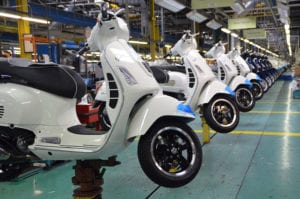
Piaggio Factory in Pontedera, Italy
Founded in Genoa in 1884 by twenty-year-old Rinaldo Piaggio, Piaggio initially undertook luxury ship fitting before going on to produce rail carriages, goods vans, luxury coaches and engines, trams and special truck bodies.
World War I brought a new diversification that was to distinguish Piaggio activities for many decades. The company started producing airplanes and seaplanes. At the same time, new plants were springing up. In 1917 Piaggio bought a new plant in Pisa, and four years later it took over a small plant in Pontedera which first became the center of aeronautical production (propellers, engines and complete aircraft, including the state-of-the-art Piaggio P108 in passenger and bomber versions). Before and during World War II, Piaggio was one of Italy’s top aircraft manufacturers. For this reason, its plants were important military targets and the Piaggio factories in Genoa, Finale Ligure and Pontedera were irrevocably damaged by the war.
The first Vespa Patent
On 23 April 1946 Piaggio & C. S.p.A. filed a patent with the Central Patents Office for inventions, models and brand names at the Ministry of Industry and Commerce in Florence, for “a motor cycle with a rational complex of organs and elements with body combined with the mudguards and bonnet covering all the mechanical parts.” In a short space of time Enrico Piaggio did not hesitate to launch factory production of 2,000 units of the first Vespa 98cc.
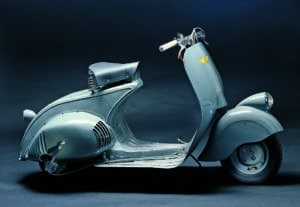
1945 Vespa MP6 Prototype
1946-2016: The Vespa Models That Have Made History
Since the first 98cc Vespa in 1946, there have been more than 150 different models, versions and variations of the Vespa – identifiable by different “chassis codes” – manufactured by Piaggio. These vehicles trace the technical evolution of the world’s most famous scooter. By the time the Vespa ET4 was launched in 1996, over 20,000 modifications had been made to the original product and over 1,500 parts replaced.
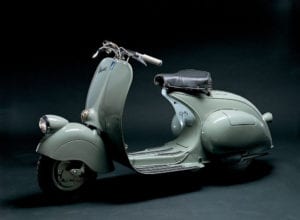
1946 Vespa 98
Vespa 98, 1946 – The first Vespa. It was powered by a 98 cc engine that delivered 3.2 bhp at 4,500 rpm with a top speed of 60 km/h. It was in production for two years: in 1946 vehicles no. 1 to no. 2,464 were produced, in ‘47 those from no. 2,465 to 18,079.
Vespa 125, 1948 – This was the first Vespa 125 cc. In addition to the different engine size, it differs from the 98 with the introduction of the rear suspension; the front suspension was also modified.
Vespa 125, 1953 – This marked the first important change to the engine: bore, stroke and timing gear were modified. Power output increased to 5 bhp at 5,000 rpm, and top speed to 75 km/h. The design of the fairing at the rear was also new.
Vespa 125 U, 1953 – The “Utility” version with Spartan styling, which sold at 20,000 lire less than the more modern 125. The headlamp appeared high up on the handlebar for the first time in Italy (it had already been introduced on a number of exported models).

1953 Vespa 125-U (Utility)
Vespa 150 GS, 1955 – Experts called it “the most popular, imitated and remembered model”. There were numerous innovations: the 150 cc engine, 4-speed gearbox, standard long saddle, “faired” handlebar-headlamp unit, wheels with 10” tires. This Vespa could reach 100 km/h. The design also changed, with a much more aerodynamic body.
Vespa 160 GS, 1962 – This was born to continue the market success of the first GS, with a completely new design. The exhaust silencer, carburetor and suspension were also new. The power output was 8.2 bhp at 6,500 rpm.
Vespa 150 GL, 1963 – Another new design for what has been called “one of the best-looking Vespas produced by Piaggio designers”. The handlebar, trapezoid headlamp, front mudguard and trimmed-down rear lids were all new.
Vespa 50, 1964 – The first Vespa 50 cc, created to exploit the new Italian Highway Code which made a number plate obligatory on larger engines. Extremely versatile and reliable, the engine featured a new layout, with the cylinder inclined 45° instead of horizontal. It was the last design to leave Corradino D’Ascanio’s drawing board.
Vespa 180 SS, 1965 – It marked a new milestone in the growth of the engine (181.14 cc), with 10 bhp for a top speed of 105 km/h. The 180 SS (Super Sport) replaced the glorious GS 150/160 cc. Piaggio modified the front cowling, making it more aerodynamic and significantly improving comfort, handling and road holding.
Vespa 125, 1966 – Unofficially known as the “new 125”, it featured radical innovations in the design, frame, engine (inclined 45°) and suspension.
Vespa Super Sprint 90, 1966 – A special series derived from the Vespa 50/90 cc and the “new” 125, the hold-all was positioned between the saddle and the handlebar for a more “laid-back” riding style. The handlebar was narrow and low, and the mudguard and cowling were streamlined. With an engine capacity of only 90 cc, it could do 93 km/h.
Vespa 125 Primavera, 1968 – Together with the subsequent PX version, it was the most durable version of the Vespa. It derived from the “new” 125, but with considerable differences in the engine, which raised the top speed by 10 km/h. Great attention was paid to details, which included the classic, practical bag hook.
Vespa 180 Rally, 1968 – With this new vehicle, Piaggio extended the rotary timing fuel feed system to its entire production. The engine was new, the front headlamp new and more powerful, the frame, derived from the Vespa 150 Sprint, narrower and more aerodynamic than that of the Super Sport.
Vespa 50 Elestart, 1970 – It featured the great novelty of electric ignition, but the design was also completely revised and embellished compared to the 50 Special. Vespa 200 Rally, 1972 – The Vespa with the largest engine. This model, with 12.35 bhp at 5,700 rpm, could reach 116 km/h.
Vespa 125 Primavera ET3, 1976 – The name stood for “Electronic 3 intake ports”, and included important changes to the engine, which had more power and sparkle. Even the styling was changed from the standard Primavera (which remained in the range).
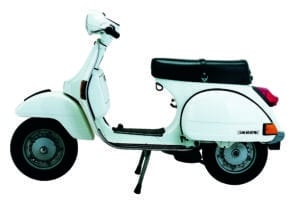
1978 Vespa PX 125
Vespa P 125 X, 1978 – The “PX” marked a new step forward in styling (the bodywork was completely redesigned) and performance. The hold-all was positioned behind the cowling. The same year the P 200 E also appeared, which, instead of the 125 version, could be equipped with separate lubrication and direction indicators incorporated in the body. Three years later the PX 150 E was launched, with performance halfway between the two models.
Vespa PK 125, 1983 – This replaced the Vespa Primavera (standard and ET3). The styling was new, and the PK body was completely different from that of previous scooters, because the welds of the body no longer overlapped but were integral. Vespa PK 50, 1983 – Substantially identical to the PK 125, it appeared in two models, PK 50 and PK 50 S, both with 4-speed gearbox and electronic ignition.
Vespa PK 125 Automatica, 1984 – An automatic transmission was introduced on the Vespa, perhaps the most radical change (at least for the user’s point of view) since 1946. The presence of the automatic transmission was emphasized by the absence of the foot brake, replaced by the lever on the left handlebar (which does not need to control the clutch, as it is automatic). It was also available with automatic oil-petrol mixer and electric ignition. The following year the Vespa PK 50 Automatic was launched.

1985 Vespa PX T5
Vespa T 5 Pole Position, 1985 – The T 5 was the “extra-sporty” version of the PX series. With a new engine, aluminum cylinder and 5 intake ports, but the design was also new, particularly at the rear and around the front headlamp which incorporated an aggressive dome with a small Plexiglas windscreen. A spoiler was added on the cowling. Vespa 50 N, 1989 – The changes to the Italian Highway Code meant that 50 cc vehicles were no longer bound by the 1.5 bhp limit, and Piaggio presented a new small Vespa with improved performance (over 2 bhp at 5,000 rpm), and new, smoother styling.
Vespa ET4 125cc, 1996 – The “new generation Vespa” with a four-stroke engine, launched on the 50th anniversary. In 1997 and 1998 it was the best-selling two-wheeled vehicle (including motorcycles) in all of Europe and it was followed by the ET2 50 cc version and then in 1999 also by the classic ET4 150 cc.
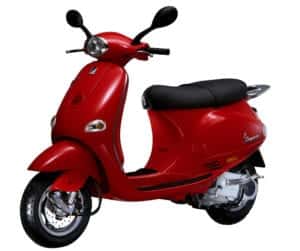
1996 Vespa ET4 125
Vespa ET4 50, 2000 -. It was the first Vespa 50 equipped with a 4-stroke engine and, thanks to the characteristics of its power plant, it established a true and proper range record: of over 500 km with a full tank.
Vespa PX, 2001 – Front disc brake, careful aesthetic operations, new colors and the return to the “historic” Vespa logo for the timeless PX, which exceeded the extraordinary figure of three million units manufactured and sold in its more than 30 year long career. Revamped again in 2011, today it is available in the 125 and 150 versions. Vespa PX is an “evergreen”, thanks in part to the 4 speed handlebar shift transmission and the possibility of installing a side spare tire.
Vespa Granturismo 200L and 125L, 2003 – In 2003, the Granturismo made its appearance as the most powerful Vespa ever produced. In 200L and 125L versions, it combines the Vespa’s emotional appeal with state-of-the-art technology: this was the first-ever Vespa to have sparkling four-stroke, four-valve, liquid-cooled engines that meet the new Euro 2 emissions standards, as well as 12-inch wheels and a two-disk brake system. The steel body is a uniquely Vespa touch.
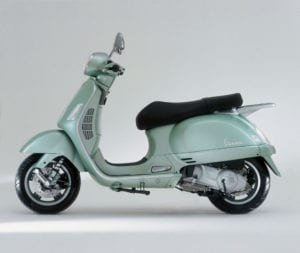
2003 Vespa Granturismo
Vespa LX, 2005 – This was the return of the “vespino”, the small body model which was offered alongside the larger “vespone” for more than 40 years, in an extremely modern stylistic and technical key. Vespa LX replaced the glorious Vespa ET (more than 460,000 units sold since 1996) and is available in four modern and ecological engine sizes: 50cc two and four stroke, 125 and 150cc four stroke.
Vespa GTS 250 i.e., 2005 – Fifty years after the launch of the Vespa GS (Gran Sport), the first sport scooter in history and still a sought after treasure for collectors and fans, Vespa GTS 250 i.e. renews the GS blend of speed and style to become the fastest, most powerful and most high-tech Vespa. From November 2011, Vespa GTS “grew” to the 300 class with an avant-garde, extremely powerful four-valve, liquid cooled engine with electronic injection. Vespa GTS is stopped with a superb double disc braking system.
Vespa GTV and LXV, 2006 – Conceived to celebrate an absolute legend in the world of two wheelers, the Vespa LXV and Vespa GTV repeat and reinterpret the most distinctive elements of ‘50s and ‘60s styling in form and function. The Vespa GTV, available with 125 and 250 cc engines, stands out for its headlight mounted on the mudguard just as the original 1946 prototype. The Vespa LXV, offered with a choice of 50, 125 and 150 cc engines, is inspired by the smooth, essential lines of the Vespas of the 1960s, and features a sleek, minimalist look characterized by open handlebars and a two part seat.
Vespa GT 60°, 250cc, 2006 – This is the gift that Vespa was determined to give its fans to celebrate the company’s sixtieth anniversary. With its prestigious materials and exclusive finish, this unique limited edition is made in a series of only 999 units, and is destined to become one of the milestones in Vespa’s long history.
Vespa S 50 and 125, 2007 – All the character of the sporty “Vespino” of yesteryear is revived by the brand new Vespa S. This fascinating blend of styles and memories keeps the soul of the youngest and most sporting of all Vespas alive in the present day. The Vespa S inherits its rigorously minimalist looks from legendary models of the 1970s like the 50 Special and Vespa Primavera.
Vespa GTS 300 Super, 2008 – GTS 300 Super brings the exclusive elegance of Vespa to the over 250 class. The classic, unique Vespa style is combined with a distinctly sporty and modern personality, giving the clean Vespa lines a decidedly rugged look. With its sporty design, the Vespa GTS 300 Super embodies the style, convenience, safety and sturdiness of the Vespa brand. With new 4 valve timing, this brand new and feisty little powerplant has nothing to envy of its two-stroke counterparts (at 4.35 hp, it is the most powerful 50 cc four stroke on the market), yet its consumption and emission figures remain those of a four-stroke.
Vespa S 50 and Vespa LX 50 4 Valve, 2009 – The new 50cc, four stroke, four valve engine leads to the rediscovery of an engine size which is “legendary” in Vespa history. With new 4 valve timing, this brand new and feisty powerplant has nothing to envy of its two-stroke counterparts (at 4.35 hp it is the most powerful 50 cc four-stroke on the market), yet its consumption and emission figures remain those of a typical four stroke. With this new engine, Vespa reconfirms a technological supremacy that has stood for over six decades.
Vespa LX 3V and Vespa S 3V – In June 2012 on the Vespa LX and Vespa S a new engine made its début, rightfully considered cutting-edge in this segment and ahead of its time in terms of performance and minimum fuel consumption and emissions, achieving mileage of 55km/l and lowering Co2 emissions by 30%. With the new and highly technologically advanced 125-150 4Stroke 3 Valve power train, Piaggio once again opens a window to the future of motoring technology. It is a single cylinder 4 stroke air cooled engine with 3 valves (2 intakes and 1 exhaust) single overhead cam and electronic fuel injection. It was designed and built in the Pontedera plant, in some of the most advanced research & development centres in the world, with the goal of increasing performance and fuel economy and lowering polluting emissions.
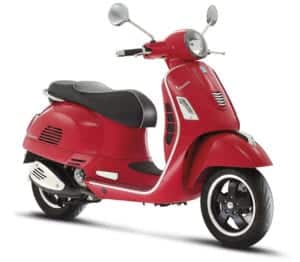
2014 Vespa GTS ABS
In 2014 Vespa GTS is new and improved with the adoption of the most advanced technological electronic riding support systems: 2-channel ABS braking system and ASR traction control. Vespa therefore reaffirms its technological cutting-edge which has always marked its past and introduces one of the most modern, advanced and safest vehicles in the world.
Article courtesy of Motorcyclist Magazine
To see more models visit Vespa International here.
